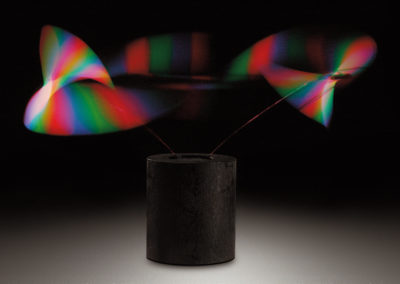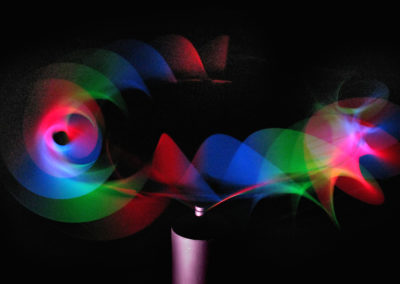IRIDESCENT “FLUTTERER” (1967)
This piece consists of a helix-shaped element and a Synthetic Light projector.
A mechanism placed inside a cylinder turns a steel rod at the end of which a white helix rotates freely.
This double rotation, of the rod through 360° and of the helix on itself, creates a global movement on which the Synthetic Light is projected.
Bands of colour appear in mid-air, in the colours that make up the beam of Synthetic Light.
In the Svolazzatore Cromocangiante, the coloured light output is detached from the reflecting support and appears in mid-air.
Synthetic Light (1965)
During the 1960s, Fogliati worked on the development of his urban projects. He wanted to introduce aesthetic presences into the environment and to act on atmospheric events in unusual ways. One of these was the colouring of rain.
Instead of trivialising the idea with simple beams of coloured light, Fogliati intended to create a truly unusual event with a light that “behaved in a ‘particular’ way”. In the mid-1960s, he designed and produced a type of light he called Luce Sintetica, Synthetic Light, or Luce Fantastica, Fantastic Light.
When the light is used to illuminate a motionless object, the beam appears to be white. When the light illuminates a moving object, then it breaks down into its constituent colours. In other words, the distinctive feature of this type of light is its ability to adapt to the characteristics of the object it illuminates. Fogliati realised that when a beam of Synthetic Light was projected on a moving object, the object would be coloured by the colours of the beam. This is what he wanted to do with rain, and he demonstrated the idea with the Prisma meccanico, the Rivelatore cromocinetico and the Svolazzatore cromocangiante.


